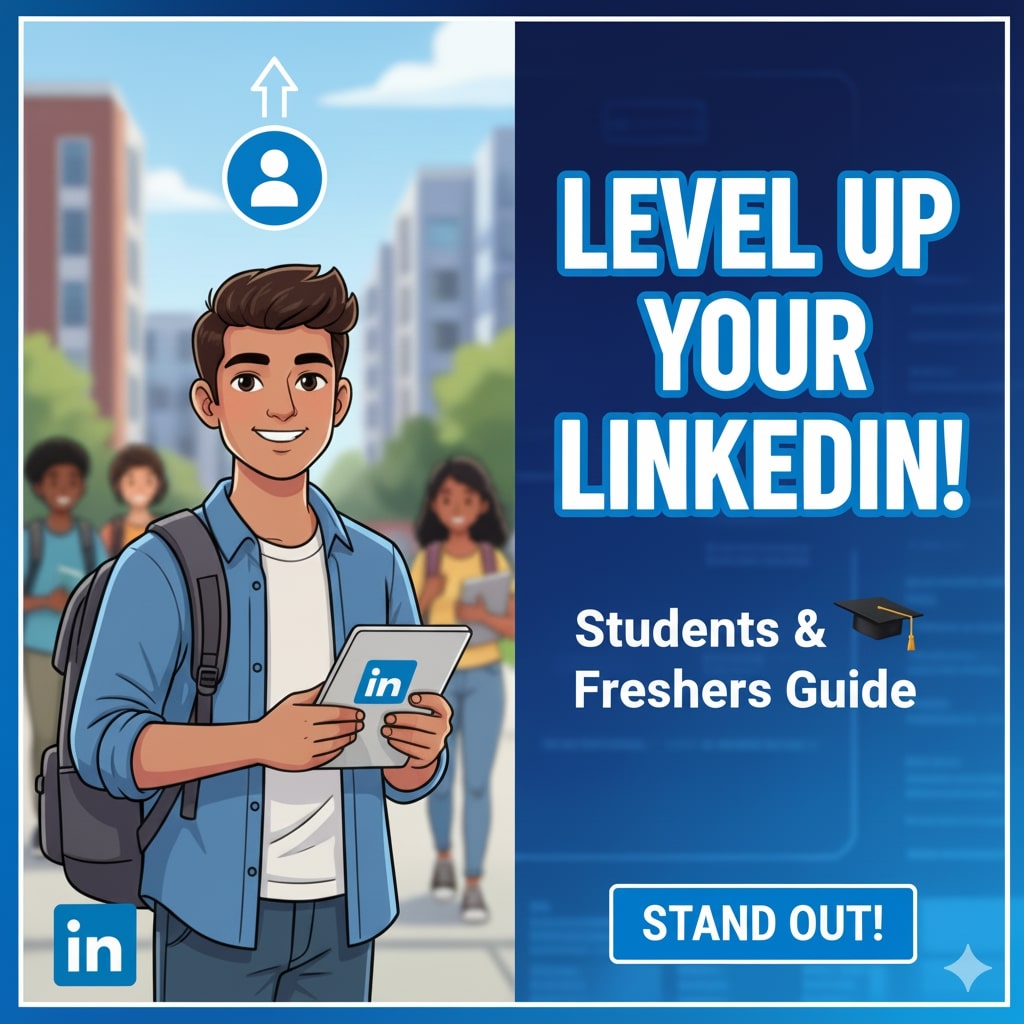For most computer science and application students, the journey into coding begins with the friendly basics of HTML and CSS. We master layout, styling, and structure, and building a static…

How to Create a Strong LinkedIn Profile as a Student
In today’s professional world, LinkedIn is more than just a social media platform—it’s your online resume, personal brand, and networking tool all in one. For college students and freshers, creating a strong LinkedIn profile can open doors to internships, jobs, and valuable professional connections. However, many students are unsure where to start or what to include. This guide walks you through each step to help you build a powerful and professional LinkedIn profile.
Step 1: Start with a Clean and Clear Profile Photo
Your profile photo on your resume is the first impression you make; it adds personality and credibility to your profile.
Tips:
- Use a clear headshot with a plain background.
- Wear simple formal or semi-formal clothes.
- Smile slightly to appear approachable and professional.
- Ensure your face covers at least 60% of the photo frame.
Even if you don’t have a professional photographer, a well-lit selfie against a plain background can work perfectly.
Step 2: Write a Catchy and Clear Headline
Your headline appears right below your name. Avoid generic titles like “Student.” Instead, describe what you study and what you’re passionate about.
Examples:
- B.Tech CSE Student | Passionate About Data Science & Web Development
- Aspiring Mechanical Engineer | CAD & Robotics Enthusiast
Your headline should quickly communicate who you are and what interests you; this makes your profile stand out.
Step 3: Craft a Strong “About” Section (Summary)
The “About” section is your personal introduction, where you tell your story, highlight your strengths, and outline your aspirations.
Structure:
- Start with your current position (e.g., “I am a third-year B.Tech student specializing in Computer Science.”)
- Describe your interests or abilities (e.g., “I enjoy working on web development, AI models, and Python projects”).
- End with your goal (e.g., “Currently exploring internships and collaborative projects to apply my skills”).
Write in a conversational and natural tone; make it sound like you. Avoid copying generic templates.
Step 4: Add Education, Skills & Courses
Your education and skills form the backbone of your student profile.
Education:
- Mention your college/university name.
- Specify your degree, major, and expected graduation year.
Skills:
- List 10–15 relevant skills, such as:
- Microsoft Excel, HTML, Java, Python, Data Analysis, Teamwork
Courses:
- Add online certifications or academic courses (e.g., “Python for Data Science-Coursera”).
These details give recruiters a clear idea of your academic background and technical skills.
Step 5: Showcase Projects, Certifications & Achievements
Even without job experience, you can highlight your projects and accomplishments to build credibility.

Projects:
- Include short descriptions of your academic or personal projects.
- Mention tools, technologies, and your role.
Certifications:
- Upload course certificates from platforms like Coursera, edX, Great Learning, or Udemy.
Achievements:
- Add awards, hackathons, competitions, or volunteer work.
- Use the “Featured” or “Projects” section to display your work visually—it helps your profile look dynamic and engaging.
Step 6: Connect and Build Your Network
LinkedIn isn’t just about showcasing your profile; it’s about connecting with others.
Start by:
- Connecting with classmates, seniors, and professors.
- Sending requests to people you meet at events, workshops, or internships.
- When sending a connection request, include a short, polite note like
“Hello, I’m a student with a keen interest in Data Science. I’d love to connect and learn from your experiences.”
Building a network helps you gain visibility, mentorship, and job referrals.
Step 7: Stay Active and Post Regularly
A strong LinkedIn profile isn’t built overnight. Staying active shows that you are engaged and learning.
- You can post about:
- New certifications or projects you’ve completed
- College achievements or learnings
- Tech- or career-related articles you found interesting
- Consistent engagement helps recruiters and peers recognize your enthusiasm and expertise.
Conclusion
A strong LinkedIn profile helps you build your professional identity early in your career. It acts as your digital resume, reflecting your skills, interests, and growth. As a student, you don’t need extensive work experience; just highlight your projects, learning journey, and ambitions clearly.
Keep your profile updated, interact meaningfully, and use LinkedIn not just for job hunting but also for learning, connecting, and growing. It’s one of the most powerful tools you can develop early in your career journey.
Latest Posts
From Hackathons to Horizons: My NASA Space Apps Journey
As a Data Science undergraduate, I’ve always been fascinated by the intersection of technology, environment, and storytelling. Among all my college experiences, participating in the NASA Space Apps Hackathon stands…
Top Government Exams You Can Prepare for After Graduation
Many Indian students face a crucial decision after graduation—whether to pursue higher studies, enter the private sector, or prepare for government exams. Government jobs in India are highly respected due…
How to Crack an Internship in FAANG
For college students, internships are more than just lines on a resume, they are gateways to real-world corporate exposure and future job opportunities. Landing an internship at a top company…
How to Build Your First AI-Powered Interest Calculator
In today’s world, financial literacy is just as important as technical knowledge. Whether you are managing your pocket money, calculating loan interests, or saving for future goals, understanding interest calculations…
Popular Posts
Best CV Formats for Freshers: Simple, Professional & Job-Winning Templates
Creating an effective CV (Curriculum Vitae) is the first step towards landing your dream job or internship as a fresh graduate. Your CV is your initial introduction to potential employers…
How to Write Mail for Job Application – Explained
A job application email is a professional email that you send to a potential employer to express your interest in a job opening. It is typically accompanied by your resume…
250+ Group Discussion Topics for Interviews with Expert GD Tips
Group discussions (GD) are a critical aspect of the interview process for college students and freshers. They are commonly used in campus placements, competitive exams, and job interviews to evaluate…
How to Write a Job Application Letter – Tips, Format, and Examples
When it comes to applying for your first job, making a great first impression is crucial. As a recent graduate, you might feel a little intimidated by the idea of…
Latest Mechanical Engineering Interview Questions and Answers
Entering the world of mechanical engineering as a fresher is an exciting journey, but the path to success often involves navigating through challenging interviews. In this guide, we’ve curated a…
